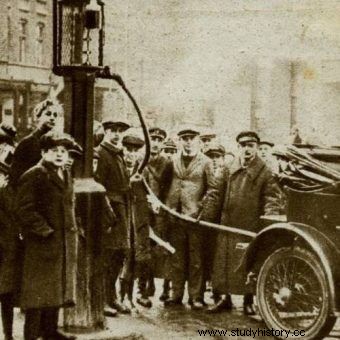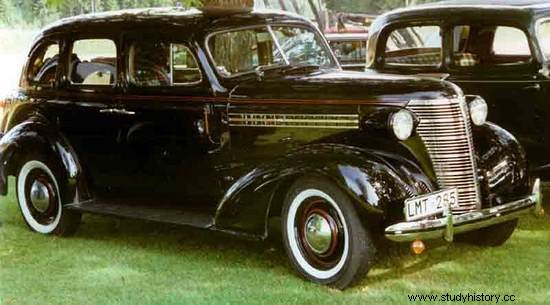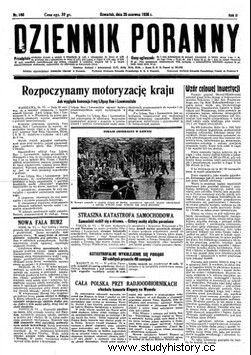Almost every car owner looks at the meter of the fuel dispenser when refueling with a heartache and a wallet. In relation to earnings, gasoline prices in our country are among the highest in Europe. Maybe you will be comforted by the fact that our great-grandparents had a lot of it
Interwar Poland can hardly be called a European leader in the field of motorization. Well, unless the leader is behind schedule. The data included in the "Little Statistical Yearbook" from 1939 leaves no doubt. During this period, only 41,948 cars were registered at the Vistula River. It should be emphasized that this number included 5,216 taxis, 2,038 buses and 8,609 trucks.
8 zlotys for a liter of gasoline
As it is easy to count, statistically, there were only 10 cars per 10,000 inhabitants. For comparison, at the same time in France the index was 523, in England 511, in the Third Reich (including Austria) 251, and in Italy 100. We were even ahead of backward Romania with 13 cars per 10,000 inhabitants!

In 1936, few people in Poland could even afford to buy a Fiat 508, which cost almost PLN 5,500. If we add high operating costs, it turns out that only the richest inhabitants of the Second Polish Republic could afford the car.
There were many reasons for this:low wages for the majority of society, expensive cars, terrible condition of roads and very high fuel prices. Yes, in the Second Polish Republic they were truly prohibitive. At the beginning of the 1930s a liter of gasoline cost over PLN 0.80, which is more than 8 modern zlotys! The Great Depression caused a slight drop in prices, but in 1936 you still had to pay for a liter of petrol - a trifle - 68 groszy.
The fact that it was a huge expense for the average Kowalski is evidenced by the fact that a worker in the clothing industry during this period earned less than 24 zlotys a week, so the equivalent of only 35 liters of gasoline. And all this in a country that was completely self-sufficient in liquid fuels. 
As is often the case, the blame for this state of affairs was largely borne by politicians who in the early 1930s had a "brilliant" idea. In February 1931, the State Road Fund was established, the budget of which was based on revenues from tolls on motor vehicles, propellants, advertisements placed by roads, as well as fines and administrative penalties for violating road traffic regulations.
In principle, the creation of the Road Fund was to contribute to a significant acceleration of the country's motorization, but of course the opposite happened.
Why so expensive?
Successive burdens, combined with the growing economic crisis, hit drivers' pockets hard. We didn't have to wait long for the effects. Many motorists had to get rid of their four wheels. The number of registered cars between 1931 and 1933 dropped drastically from 39,400 to just 26,000. The fuel price, however, continued to break records.

The Fiat 508, however, is still nothing compared to, for example, the Chevrolet Master installed at that time. It cost over PLN 7,600 and burned almost 14 liters per 100 km. So a weekly wage for a worker would allow him to travel only 250 km (photo:Lars-Göran Lindgren; license CC ASA 3.0).
Reading one of the issues of the Poznań Daily Daily, we will learn what exactly these 68 groszy per liter of gasoline made up. The author of the article calculates that of this the refinery receives PLN 0.26, i.e. 38%, the rest, i.e. 42 gr. breaks down into the following items:
Tax for the Road Fund 8.8 gr., food tax 11.2 gr., turnover tax 2 gr., freight from Drochobycz to Warsaw 7.1 gr. per liter (?), city tax for a street pump PLN 2.9, pump service PLN 0.04, other costs PLN 0.06.

The title page of "Dziennik Morning" from June 25, 1936, which describes in detail what made up the price of gasoline in the Second Polish Republic.
As we can see, taxes are more than half of the above-mentioned PLN 0.22, but in the previous years it was even worse. Only in the second half of the 1930s - due to drivers' protests - a certain reduction in rates was decided. However, it did not change the fact that the fuel price was horrendously high for those conditions.
The members of the automotive committee at the minister of communications were well aware of this. In the spring of 1936, they even called for lowering the price to PLN 0.35 per liter of gasoline. Has anything come of it? Of course not. The Minister of the Treasury did not consider granting the request that would reduce the budget revenues . Some things never change.
